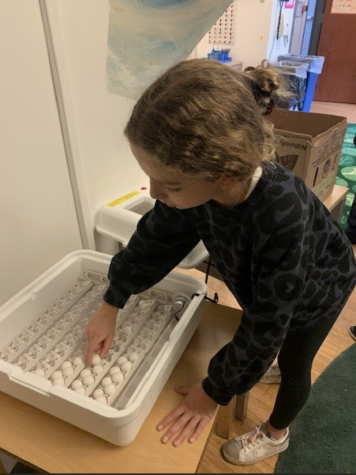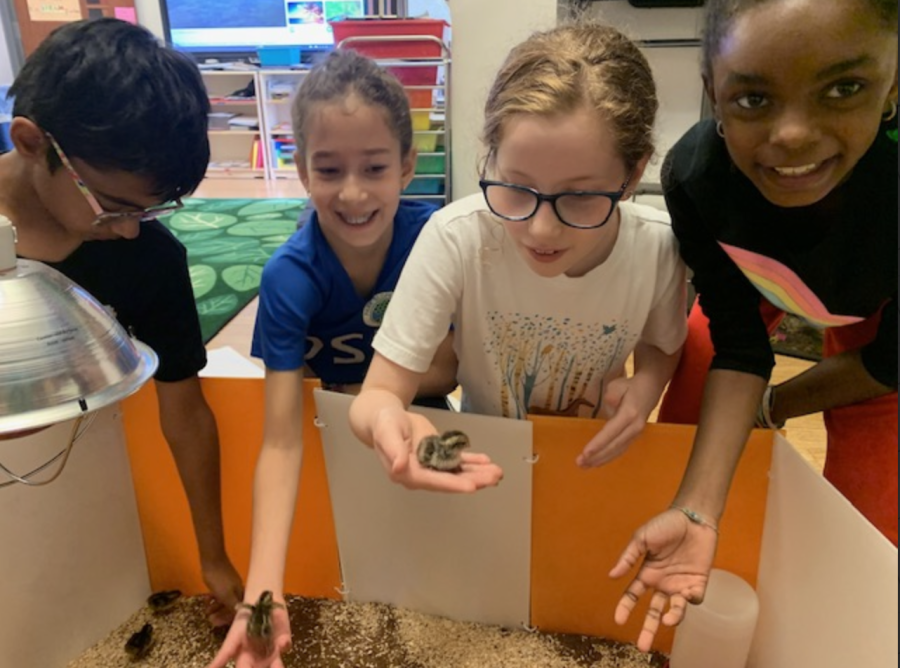Lower Schoolers Get Sustainable
June 15, 2023
The students at Poly Prep’s Lower School are deeply involved in sustainability and service learning, yet their work remains largely unknown to the Middle and Upper Schools. So, to shed some light on what they do, I traveled from Dyker Heights to Park Slope and worked with the journalists of the Lower School newspaper to report on sustainability and service learning from their point of view.
At the Lower School, both sustainability and service learning are woven into the curriculum so that students are educated and then inspired to act on the issues facing their community. Their teachers hope that lessons, projects, and activities in class will build habits of making sustainable choices and helping others in their students. As science teacher Carmen Dreyer, the Lower School sustainability coordinator, said, “it’s about changing these small events, changing the way people think, so that [for] every choice that people make, they’ve grown up around this culture of non-waste.”
To Dreyer, “there’s enough stuff to do that I could completely take over the whole curriculum and make it all about sustainability for all grades for all the time,” but for now, she teaches her science class through a lens of sustainability. For example, she made her third grade class the “sustainability masters” of the school, dividing them into five squads to oversee sustainability programs and get their classmates involved. “They like to communicate, they like doing, they like acting and going through the school and teaching other kids, so they’ve been really excited about it,” said Dreyer of the third graders.
Dreyer spoke on the phone from Long Island, where she is returning quails hatched by her class to their natural environment. “I try to be really thoughtful about every choice that I make as a teacher, a science teacher, a human being, a parent,” she said. “We need to be really thoughtful when we have animals in our lives. They’re not disposable.”
So, when it comes to teaching her students biology, Dreyer has a new strategy. Instead of the chickens that many elementary school science classes hatch but have no place for, Dreyer’s class hatches Northern bobwhite quails. The quails are native to Long Island, where they play a valuable role in the ecosystem by eating ticks and weeds, but their population has “declined seriously,” according to The National Audubon Society. Dreyer said this is largely due to humans and their housecats, who prey on the quails. Therefore, in hatching quails and bringing them to Long Island, “we’re helping to restore this ecosystem, we’re helping to restore this balance of nature, and yet at the same time, we’re also getting this amazing experience of children being able to watch these cute little birds hatch out of these eggs. We’ve learned so much about how this happens,” said Dreyer. The quails are just one example of the many ways in which Dreyer ensures that both the means and the ends of her lessons are beneficial to the environment.
Just like Dreyer does with sustainability, the Lower School’s Service Learning Co-Coordinators, Spanish teacher Sarah Ely and Associate Teacher Marie Vizzoti, make service learning a part of class at the Lower School so that “students are getting involved with what they’re learning in the classroom and applying it to doing a service learning project in real time,” as Ely said. Ely and Vizzotti find community organizations for Poly to partner with, make service learning lesson plans for teachers to use, and support students and teachers in creating service projects based on their interests. According to Ely, there are currently around eight service learning projects throughout the Lower School’s classes, including first grade’s work to help refugees and migrants, the letters written by second grade to persuade Mayor Adams not to suspend New York City’s Right to Shelter, and discussions about poverty in pre-K. Vizzotti said, “we’re focusing on poverty in pre-K, and so they’re learning about wants versus needs.. Then, we come together [to see] what we can do as a community, as people who have what they need.” The pre-K students were asked to complete the sentence “if I had money, I would give it to somebody to…” Their ideas included “a bed,” “food,” and “a house,” all things they identified as “needs” through their lesson. By integrating service learning into the curriculum, the Lower School is teaching children as young as four to understand important issues and to create change.
Sustainability and service learning play an important role outside of the classroom as well. Dreyer has led projects like Tees to Totes, in which students turned old t-shirts into tote bags, and the Great Halloween Costume Swap, a part of Homecoming’s Pumpkin Patch in which families could swap their past Halloween costumes to find new ones for their kids while preventing waste. Meanwhile, Ely said that service learning outside of class “can look like anything from doing a drive, to helping to clean up somewhere, like the park, to writing letters and doing a campaign.” This year alone, the Lower School has had eight major service events: a cleanup of Prospect Park, a toy drive, a coat drive, a pajama drive, and three Pack Out Days, in which Poly community members from all three divisions worked together with One Love Community Fridge to pack up food for people in need. Vizzotti said the Pack Out Days were “such a success because it was great to see our Lower School people get so involved, and it was nice to see teachers there too, and the experience of coming together as a community was just really heartwarming.”
Going forward, Dreyer, Ely, and Vizzotti all hope for greater partnership between the Park Slope and Dyker Heights campuses in pursuit of sustainability and service learning. Dreyer said that “our individual choices matter, but if we really want change, we have to get people changing the actions of big companies…I’d love for people to think bigger…We’re a very privileged community and we need to fight for climate justice, because people who are not as privileged are the ones who are suffering. It’s up to us.” She hopes that Poly’s divisions can work together to further current sustainability efforts and push for change on a more systemic level. In terms of service learning, Ely said that “we’re working towards having students lead service learning work,” inspired by the Upper School’s Student Service Board, while Vizzotti said that “I always enjoy when older students work [with younger students], like when we had some of the older students at the Pack Out Day. It was cool to collaborate with them.” Vizzotti wants more opportunities for service-oriented collaboration, especially between the Middle and Lower Schools.
Despite their age, or maybe because of it, the Lower School students care deeply about sustainability and service learning. They also understand far more about these subjects than older people might recognize. “I think that sometimes, grown-ups that I’ve encountered feel like they don’t want to talk about [sustainability], but I’ve found that kids really do want to talk about it. Actually, they’re very interested…Children really do understand a lot about being fair, and being fair to the animals and plants, and how we can treat them better,” said Dreyer. Vizzotti echoed her, saying “they understand fairness. They understand what unfairness is. I see a lot of them get passionate about knowing that people aren’t getting enough… It’s great to see that awareness start so young, and also [to] know what we can do about it.” She continued, “We’re aware and knowledgeable down here. I think it’s always overlooked because they’re kids, but we have really great conversations, and they are a lot more in tune than people realize. I want to get them ready as early as possible to get involved in this world.” Having worked with the Lower School journalists on this story, I can definitely agree. They may be young, but the Lower School students are ready to change the world.
Additional Reporting by Ariana S., Leila R., Liliana R., and Zara G.


























